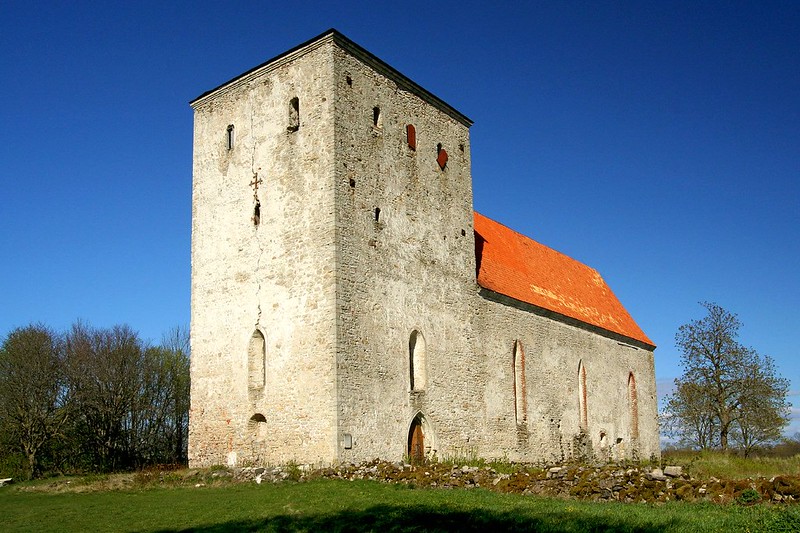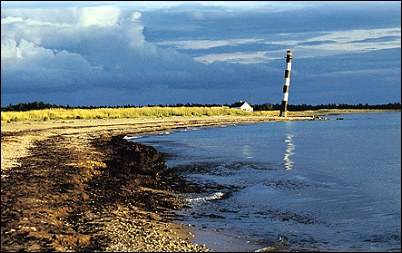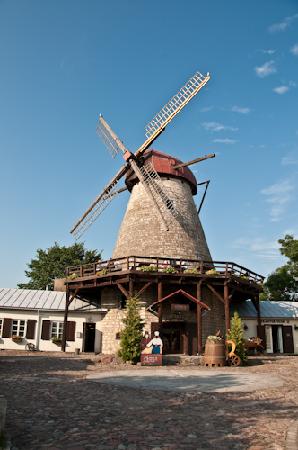Estonia – Hiiumaa, Saaremaa August 3, 2019
MUHU
Ferry to Saaremaa. Departs from Virtsu every 30 minutes. €11.40 one-way. It is a little confusing as there are 3 lines: one for e-tickets, unbooked tickets and over-height vehicles. 20 minutes.
The first island in the chain is Muhu. Like the rest of Estonia, it consists of forest (mostly pine and some birch), farms and fields with the only crop of hay. The economy is based on logging and farming.
Nõmmküla, In the NM “villages” series, it is hard to call this a village as it is a small collection of scattered farms with no businesses or center on the north side of the island. Virtually every structure is made with the same white limestone “bricks” that I assume came from the Rummu Prison Quarry.
SAAREMA
Pöide Church (St Mary’s Church), Pöide. The oldest part is the 1230 Romanesque Chapel (the only one of its kind in Estonia). It was built taller, longer, vaulted and decorated with intricate and elaborate stone carvings (vines, rose blossoms on the capital’s keystone and portals) by the Teutonic Livonian Brothers of the Sword around 1400. The doorways and windows remain but only some of the paintings remain. After the Reformation, it became Lutheran, However, ⅔ of the congregation converted to Orthodox in the middle of the 19th century. In 1940 lightning caused a fire that destroyed the spire. The church was pillaged between 1944-47 in WW II and the church was closed. Restorations occurred in the 50s and between 1990-2012 with the restoration of the congregation in 1990.
The exterior is rough field stone. Most of the windows are high and narrow like a fortified church and have nice stained glass. A foundation and ruined low walls are on the north side and the remains of the Livonian fort that was destroyed in 1343 are also on the north side. On the west wall, the rose window was bricked in and the cross of the order is visible.
On a Saturday morning, the door was locked, but a young woman came and opened the church so I had a good look inside. Wood scaffolding was supporting the roof of the tower. The inside was in rough shape with about half the plaster missing from the brick walls. It doesn’t appear to be used for services as there were only some dirty rough benches to the
side.

Angla Windmills, Angla. There are 5 windmills here, all with vanes and sided with unpainted wood. Four are square two-story on stone foundations with beams to turn them into the wind and one of these had its vanes rotating. One is larger, a tapering hexagon with a top turned using an exterior tripod moved from a small balcony at 3 meters. Several can be entered, but none rotate the guts of the mills. There is a collection of millstones and several rusted tractors and farm machinery. €4, no reduction

Mihkli Farm Museum (Mihkli Talumuuseum saaremaal). This open-air museum has several combined stone/log houses, 3 with thatched roofs, a windmill and traditional furniture, and many farm implements and crafts. An ancient moss-covered stonewall surrounds these two farms together. €4, 3 reduced
Vilsandi National Park. This national park in Saare County includes part of the island of Vilsandi, several smaller islands, adjacent parts of western Saaremaa and the Harilaid peninsula on Saaremaa, all in Kihelkonna Parish and Lääne-Saare Parish.
The park grew from a bird reserve founded in 1910. It is a highly sensitive ecosystem due to the use of the area as a stop-over by many migratory birds, like barnacle geese and Steller’s eider, and as a breeding and nesting ground for over 247 species of birds, of which the most common is the eider duck. One-third of all protected plant species in Estonia can also be found in the national park. Hunting is absolutely prohibited. This park is a popular tourist destination for both Estonians and foreign visitors, particularly from Finland.
KURESSAARE (pop 13, 275)
It is the capital of Saare County and the westernmost town in Estonia. Its historic name was Arensburg (middle high German for eagle). The town grew around the fortress. The island was first conquered by the Livonian Brothers of the Sword in 1227. After the Livonian War (1558-83) against Russia, the island was sold to Denmark and then returned to Germany. It was under Swedish control from 1642-1721.
Kuressaare Castle-Fortress (Arensburg). A tentative WHS (18/04/2002), it is one of the best-preserved fortifications in Estonia as, unlike most Estonian medieval castles, The castle was first mentioned in 1381. It survived the Livonian War and continued to develop under its new and changing owners. It is moated, square with 4 star-shaped corner ravelins, a cannon tower and a curtain wall surmounted by dirt and under barrel-vaulted rooms. In the centre is a large “convent” building with 2 large towers. It has a courtyard and holds the regional Saarema Museum that tells the history of the castle, island and its people. The upper floors have scenic views of Kuressaare. No English. €8, 6 reduced

Kuressaare beach. Directly in front of the castle, this fine red-sand beach forms a crescent around the end of a narrow bay. There are 4 beach volleyball courts and a slide in the water.
Kuressaare windmill. This lovely big round Dutch-style windmill is stone and tapers towards the top. Built in 1899, it functioned as a windmill until 1941. In 1940, it had its vanes sawn off to prevent the enemy from using it to signal as had happened in WW I. Then it became a store with an apartment for the keeper. In 1972-74, it was restored to be a restaurant. The bottom floor was used to store grain. It then has 3 floors with tables with the 3rd floor having a balcony from which the miller could turn the top using a tripod device to face the wind. The 4th floor has the hopper into which grain was fed. The 5th has a gearing mechanism that turns the horizontal power into vertical. There is copious outdoor seating in this very popular restaurant. Many of the tables are polished granite
millstones.

GO TO Estonia – Coastal